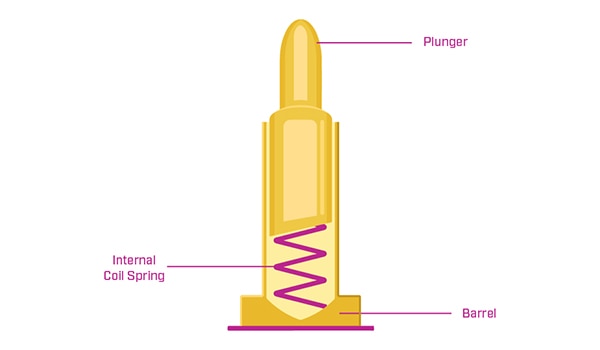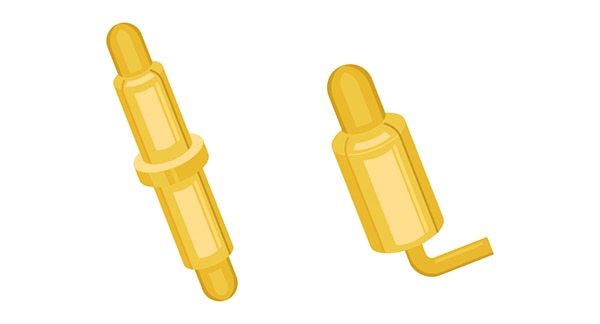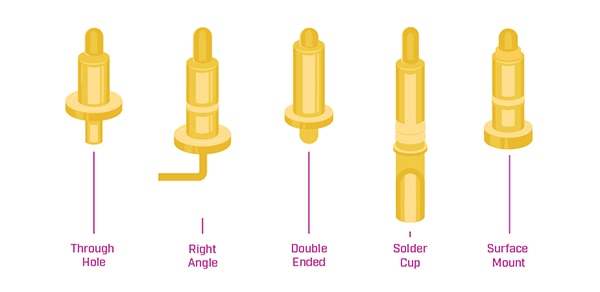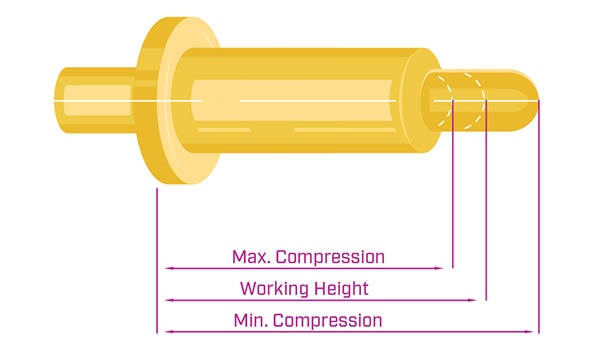弹簧针连接器的基础知识
2024-11-19
弹簧针是一种结构紧凑的弹簧连接器,广泛应用于电子系统中,可通过其接触点确保可靠的电气连接。从结构上看,弹簧针由一个内含弹簧的圆管组成,通过弹簧压缩销钉并保持稳定的接触压力。这种设计使其在视觉上酷似经典的弹簧单高跷,这也是这种连接器名称的由来。
有趣的是,最初的弹簧单高跷玩具是由 Max Pohlig 和 Ernst Gottschall 研发的,他们将自己姓氏的前两个字母组合在一起,用作这个产品的名称。不过,除了运动方式和名称相似之外,弹簧单高跷和弹簧针在功能和设计上就没有什么相似之处了。本文将详细介绍弹簧针及其优点、常见样式和设计注意事项。
弹簧针的基础知识
弹簧针于 20 世纪 70 年代初在贝尔实验室首次开发完成,因为其适合高精度、微型化和可重复的电气连接,最初为半导体测试设备设计。随着在机械稳定性、电流处理能力和紧凑设计方面的不断进步,弹簧针在工业领域的作用也得到了显著扩大。这些改进使得弹簧针的应用领域非常广泛,足以涵盖消费电子产品、工业系统和医疗设备。
每个弹簧针都由三个主要部件组成:圆管、柱塞和内部螺旋弹簧。弹簧针的典型材料是黄铜或铜合金且表面镀镍,所以耐用、耐腐蚀。对于要求较低接触电阻的应用,通常会使用镀金和其他贵金属镀层。在高密度固定装置中,弹簧针排列紧密,以便在电路板上或经常插拔的连接器内形成多个接触点。这种密集型结构可实现高效、可靠的连接,可反复使用。这种特性在许多现代电子应用中至关重要。
 图 1:典型弹簧针的基本组成部件。(图片来源:Same Sky)
图 1:典型弹簧针的基本组成部件。(图片来源:Same Sky)
除了成本优势外,弹簧针还具有众多工程优势,可提高设备性能,延长使用寿命:
- 节省空间和高度:弹簧针可节省宝贵的电路板空间,降低装配高度,是紧凑型设计的理想之选。
- 经久耐用和抗冲击:弹簧针设计精良,经久耐用,可承受多次配接操作,并且抗机械冲击、抗振动。
- 更长的接触行程:由于接触行程大,弹簧针可适应热膨胀和收缩,保持连接稳定。
- 精确装配:机器安装可实现精确定位,确保连接稳定可靠。
- 自动对准:弹簧针与配接插座自然对齐,简化了装配过程并提高了可靠性。
- 恒定接触力:弹簧机构保持恒定压力,防止在不同条件下出现连接脱落。
- 适应性强的设计:弹簧针可根据不同的电路板配置进行定制,以满足各种不同的制造要求。
弹簧针提供多种规格选择,包括不同的长度、直径、材料、操作力、额定电流、焊盘布局和柱塞样式。这种适应性使弹簧针适用于从具有挑战性的工业环境到日常消费电子产品的广泛应用。
弹簧针的类型和安装方式
如前所述,弹簧针的连接方案多种多样,可满足特定的应用要求、生命周期需求和定制选择。以下是一些比较常用的弹簧针功能,工程师可以根据电气、机械和环境需求对进行设计优化:
- 大电流:设计用于处理大小通常为 2 A 至 8 A 的电流,还可为要求苛刻的应用提供额定值更大的版本
- 高频率:适用于高速应用,可支持高达 10 Gbps 的数据传输速率
- 防水:内置密封装置,可防止水和湿气侵入,是户外和恶劣环境应用的理想之选
- 磁性:利用磁力建立并保持安全的极化连接
- 小弹簧力:设计时降低了弹簧张力,使接触点受力最小,适用于精密连接
- 滚珠触点:触点端有一颗滚珠,即使触点之间有移动,也能保持信号的连续性
- 带螺纹螺钉:柱塞或圆管上都带有螺纹,可安全地固定在板子或设备上
- 焊杯:弹簧针背面有一个小焊杯,可直接连接电缆
- 双端:两端都有弹簧触点,便于两侧连接
- 垂直或平底:从电路板垂直延伸,可实现高效的板对板连接
- 直角(水平):与电路板成 90° 角,支持水平设备安装
- 浮动式:一端为标准弹簧触点,另一端为弧形触点,可防止过度压缩,同时允许两端用于连接
 图 2:双端和直角弹簧针示例
图 2:双端和直角弹簧针示例
弹簧针通常作为独立元件采购,可根据特定电路板或夹具进行定制。这种灵活性使弹簧针成为满足精确连接要求的定制互连解决方案不可或缺的一部分。不过,在某些情况下,现成的连接器阵列包含绝缘外壳中的弹簧针 ,通常配有安装五金件,如果符合设计要求,可以简化装配过程。
对于定制的电路板或夹具组件,有多种插入和安装选项可供选择,以适应不同的应用:
- 插入类型:弹簧针可采用多种插入方法,包括压装、挤锻压、压接、焊接,甚至无焊接,且每种方法都具有独特的优势,具体取决于应用的机械和电气要求。
- 安装技术:安装配置包括表面贴装、通孔、电线安装和自由悬挂式,以适应不同的电路板设计和互连设置。
 图 3:常见的弹簧针选项(图片来源:Same Sky)
图 3:常见的弹簧针选项(图片来源:Same Sky)
插座或目标点
电气连接器的主要功能是连接或配接两个或多个组件。对于传统连接器,通常需要在两端各安装一个兼容型固定装置。不过,弹簧针的用途更为广泛,因为这种连接器不仅可以通过与插座或插口匹配建立连接,还可与电路板上的特定目标点直接接触。
这些目标点可能包括指定的元件、电路板上的镀层接触区或专为测试集成电路而设计的定制芯片插座。目标点的作用是提供一个可靠的电气连接点,使弹簧针能够接触并保持稳定,直到故意使其脱离连接为止。
最终的设计考虑因素
要指定理想的弹簧针 ,最终应考虑以下关键因素:
- 尺寸和形状:根据空间限制和机械配合情况确定引线尺寸、弹簧针的直径和形状(如圆形、方形或矩形)。
- 触点材料:根据导电性、耐用性以及与设计中其他材料的兼容性,可选择黄铜、铜、镍或青铜等材料。
- 触点镀层:根据所需的接触电阻、耐腐蚀性和耐用性选择镀层材料,如金、银、镍、钯、锌、锡或铅。
- 电气指标:评估接触电阻和额定电流,确保弹簧针能够承受所需的电气负载,而不会过度损耗或发热。
- 运动:指定柱塞尺寸、工作高度(以获得最佳柱塞行程)和尺寸公差,以确保在应用中可靠地接触和压缩。
- 物理指标:考虑接触所需的初始操作力和保持接触的中期压缩力,确保弹簧钉的力符合设计的机械和耐用性要求。
- 环境因素:考虑可能暴露于极端温度、冲击、振动、腐蚀性环境和湿气的情况。选择专为恶劣环境设计的弹簧针可确保恶劣条件下的使用寿命和性能。
 图 4:最大和最小压缩量以及建议的工作高度通常在弹簧针原理图中给出(图片来源:Same Sky)
图 4:最大和最小压缩量以及建议的工作高度通常在弹簧针原理图中给出(图片来源:Same Sky)
结语
弹簧针的设计简单耐用,可为各种设备提供可靠、一致的电气连接。这种简易性使弹簧针能承受成千上万次配接和拆配接操作,在高使用率应用中尤其经久耐用。其弹簧加载机构还能补偿连接过程中的微小偏差,确保即使出现微小的位置偏移也能保持性能稳定。此外,弹簧针还具有高性价比和高空间效率,因此在许多对结构紧凑、可靠性和预算要求极高的现代电子应用中,弹簧针都是首选的连接解决方案。查看 Same Sky 可在 DigiKey 购买的 弹簧针连接器。
免责声明:各个作者和/或论坛参与者在本网站发表的观点、看法和意见不代表 DigiKey 的观点、看法和意见,也不代表 DigiKey 官方政策。






